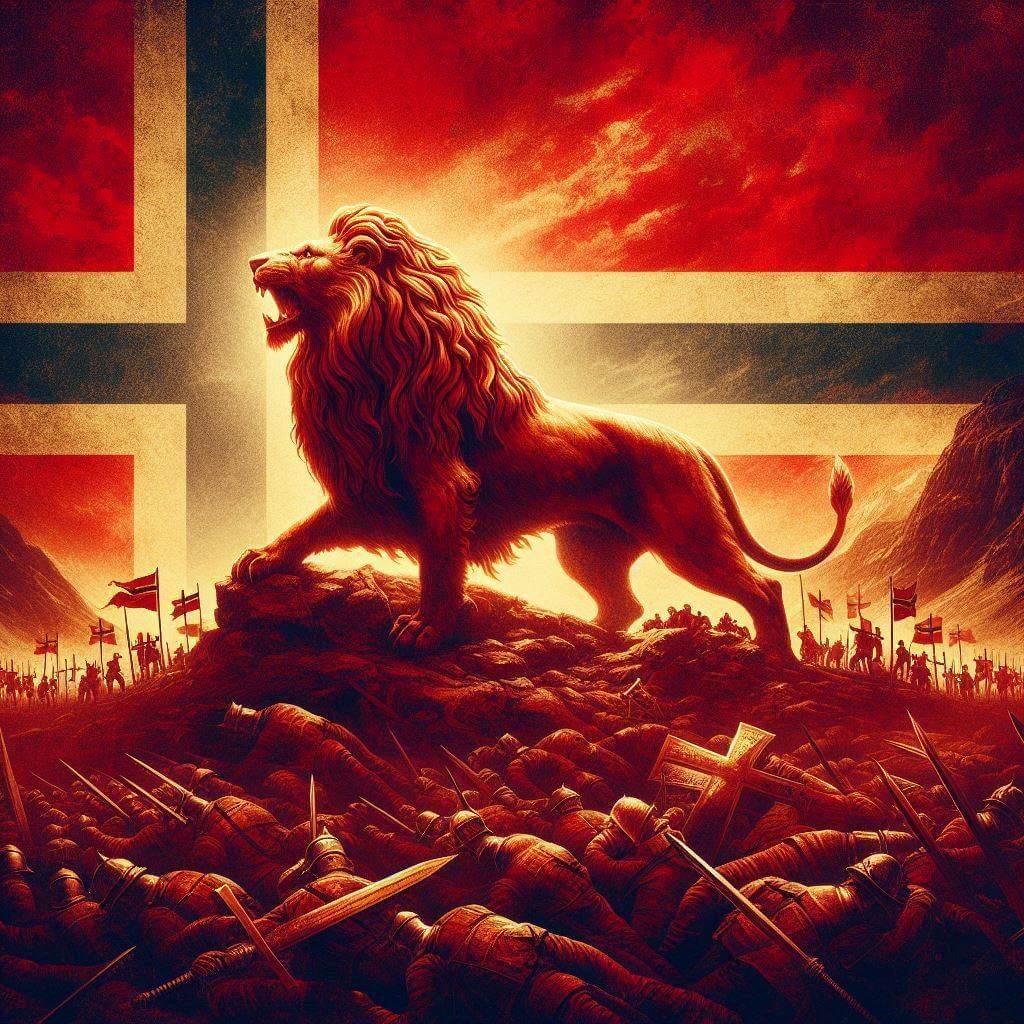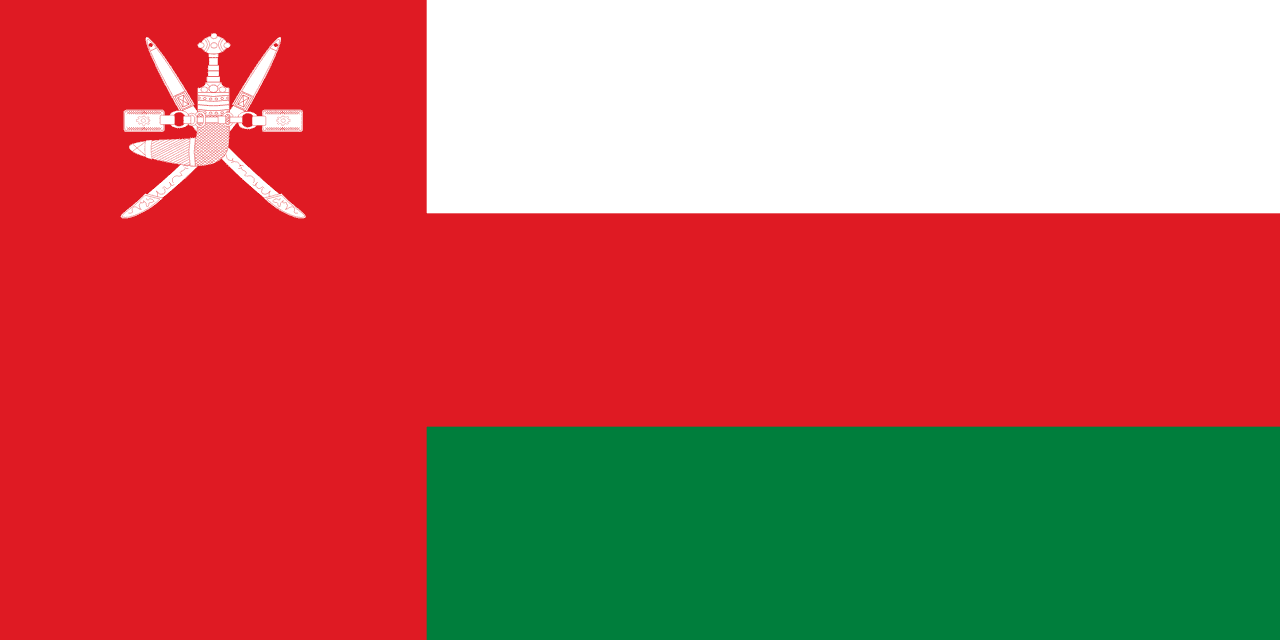La bandera de Noruega, conocida como el "Dannebrog", presenta un campo rojo vibrante con una cruz nórdica azul delineada en blanco que se extiende hasta los bordes de la bandera. Este diseño icónico, compartido en varias formas por otros países nórdicos, refleja la rica historia, el patrimonio cultural y los lazos regionales de Noruega.
Información sobre Noruega
| Día Nacional de la Bandera | 17 de mayo |
| Estado soberano | Sí |
| Nombre oficial | Reino de Noruega |
| Capital | Oslo |
| Población | 5,347,774 |
| Área | 323,802 km² |
| Moneda | Corona noruega (NOK) |
| Idioma | Noruego (Bokmål y Nynorsk) |
| Continente | Europa |
| Región | Europa del Norte |
| Subregión | Escandinavia |
| Fronteras | Suecia, Finlandia, Rusia |
| Zona horaria | Hora Central Europea (CET) UTC+1 |
| Código de llamada | +47 |
| Dominio de nivel superior | .no |
Historia de la bandera de Noruega
 El diseño actual de la bandera de Noruega fue adoptado oficialmente el 17 de julio de 1821, poco después de que Noruega obtuviera la independencia de Dinamarca. Sin embargo, sus raíces se remontan a 1318, cuando el escudo de armas de Noruega presentaba un león dorado sobre un campo rojo. El diseño de la cruz nórdica se inspiró en la bandera danesa, reconociendo la historia compartida de los países bajo la Unión de Kalmar.
La adopción de la bandera marcó un hito significativo en el camino de Noruega hacia la plena independencia, que finalmente se logró en 1905 tras la disolución de la unión con Suecia. A lo largo de su historia, la bandera ha simbolizado la lucha de Noruega por la soberanía, sus valores democráticos y su identidad nacional distintiva.
El diseño actual de la bandera de Noruega fue adoptado oficialmente el 17 de julio de 1821, poco después de que Noruega obtuviera la independencia de Dinamarca. Sin embargo, sus raíces se remontan a 1318, cuando el escudo de armas de Noruega presentaba un león dorado sobre un campo rojo. El diseño de la cruz nórdica se inspiró en la bandera danesa, reconociendo la historia compartida de los países bajo la Unión de Kalmar.
La adopción de la bandera marcó un hito significativo en el camino de Noruega hacia la plena independencia, que finalmente se logró en 1905 tras la disolución de la unión con Suecia. A lo largo de su historia, la bandera ha simbolizado la lucha de Noruega por la soberanía, sus valores democráticos y su identidad nacional distintiva.
Simbolismo y diseño de la bandera de Noruega
El diseño de la bandera de Noruega está lleno de simbolismo, reflejando la historia, los valores y la belleza natural del país. El fondo rojo representa la sangre derramada por la independencia de Noruega, así como el espíritu vibrante del país y la calidez de su gente. También rinde homenaje al escudo de armas histórico que presenta un campo rojo. La cruz nórdica azul, delineada en blanco, tiene múltiples capas de significado. Principalmente, simboliza la herencia cristiana de Noruega, que se remonta a la conversión del país en el siglo XI. El color azul a menudo se asocia con los fiordos del país, los cielos despejados y la libertad que los noruegos aprecian. El contorno blanco de la cruz representa la paz, la honestidad y las montañas nevadas que caracterizan gran parte del paisaje de Noruega. El diseño de la cruz nórdica en sí conecta a Noruega con sus vecinos escandinavos, reflejando lazos culturales e históricos compartidos mientras mantiene una identidad distintiva a través de su combinación de colores única.
Uso y significado de la bandera de Noruega
 La bandera de Noruega tiene una inmensa importancia en la sociedad noruega y es una fuente de gran orgullo nacional. Se muestra prominentemente en edificios gubernamentales, escuelas y residencias privadas, especialmente durante días festivos y celebraciones nacionales. El más significativo de estos es el Día de la Constitución el 17 de mayo, cuando las calles de Noruega se llenan de banderas y los tradicionales adornos rojos, blancos y azules.
Internacionalmente, la bandera noruega representa al país en funciones diplomáticas, eventos deportivos y foros globales. Es un símbolo del compromiso de Noruega con la democracia, los derechos humanos y la cooperación internacional, valores por los cuales el país es ampliamente respetado en el escenario mundial.
La bandera también juega un papel crucial en la tradición marítima de Noruega. Como una de las principales naciones navieras del mundo, la bandera noruega es una vista común en los barcos de todo el mundo, simbolizando el patrimonio marítimo del país y su moderna destreza marítima.
La bandera de Noruega tiene una inmensa importancia en la sociedad noruega y es una fuente de gran orgullo nacional. Se muestra prominentemente en edificios gubernamentales, escuelas y residencias privadas, especialmente durante días festivos y celebraciones nacionales. El más significativo de estos es el Día de la Constitución el 17 de mayo, cuando las calles de Noruega se llenan de banderas y los tradicionales adornos rojos, blancos y azules.
Internacionalmente, la bandera noruega representa al país en funciones diplomáticas, eventos deportivos y foros globales. Es un símbolo del compromiso de Noruega con la democracia, los derechos humanos y la cooperación internacional, valores por los cuales el país es ampliamente respetado en el escenario mundial.
La bandera también juega un papel crucial en la tradición marítima de Noruega. Como una de las principales naciones navieras del mundo, la bandera noruega es una vista común en los barcos de todo el mundo, simbolizando el patrimonio marítimo del país y su moderna destreza marítima.
Datos interesantes sobre la bandera de Noruega
- Noruega tiene reglas específicas sobre la etiqueta de la bandera, incluidos los horarios para izar y arriar la bandera y los métodos adecuados de eliminación para las banderas desgastadas.
- La bandera noruega inspiró el diseño de la bandera de Islandia, mostrando las fuertes conexiones culturales entre los países nórdicos.
- Durante la Segunda Guerra Mundial, la bandera se convirtió en un poderoso símbolo de resistencia contra la ocupación nazi, con banderas en miniatura usadas como emblemas patrióticos.
- Las proporciones de la bandera noruega no están fijadas por ley, lo que permite variaciones en la forma mientras se mantiene el diseño básico.
- La bandera de Noruega a menudo se refiere como "el rojo, blanco y azul", similar a las banderas de otras naciones, pero su diseño único y tono de azul la hacen instantáneamente reconocible.





